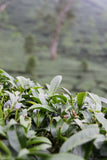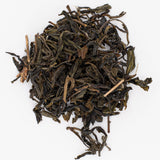
Exploring the Terroir of Taiwan's Five Tea-Growing Regions
Michele LillieTaiwan, the heartland of Oolong tea, boasts a rich and diverse tea culture deeply rooted in its distinct terroirs. The island's varying landscapes, elevations, and microclimates give rise to a remarkable array of tea-growing areas, each with its own unique character. In this article, we'll delve into the enchanting world of Taiwanese tea and explore how these different terroirs influence the flavors and aromas cherished by tea connoisseurs worldwide.
The Landscapes of Taiwan
Taiwan is only the size of Delaware and Maryland combined, but there is significant variation in climate and geography. Taiwan’s climate varies from subtropical in most areas to tropical in the south.

About two-thirds of the island is mountainous. There are five mountain ranges with 20 peaks over 9800 feet. The mountainous terrain provides the perfect environment for growing tea. The factors of elevation, cool and moist air, slower growth, and fertile, volcanic soil gives the tea a one-of-a-kind flavor and aroma.
Taiwan emphasizes quality over quantity, which shows in the tea they produce. Tea is part of the social fabric of Taiwan. There is supposedly a famous Taiwanese phrase, “You have friends, and you have tea – so you’re rich!”
The Taiwanese are very serious about their teas and are known for tea competitions and research centers, which are constantly working on developing new cultivars of the Camellia Sinensis plant.
The five tea-producing regions in Taiwan
Northern Taiwan, including Taipei and Ilan counties. It is the most northern tea-growing region and is home to some of the oldest tea farms. They produce both green and oolong teas.
Wen Shan District
Wen Shan has been growing tea for around 200 hundred years. One of the most famous tea-growing areas is Pinglin. It is considered to be the "tea capital" of Wenshan. Over 80% of residents are said to be involved in the tea business in one way or another.
This area is also home to what claims to be the biggest tea-dedicated museum in the world. The museum highlights tea-making and tea cultivation processes but also the influence of tea on Chinese and Taiwanese culture.
The mountains of Wen Shan are particularly well suited for growing tea, with altitudes around 800 meters. The region has four distinct seasons, high elevations, abundant rainfall and fertile soil.
Whereas most Taiwanese oolongs are sold in rolled or balled styles, Bao Zhong is one of the few remaining teas made with long, strip-style leaves. The technique started in Anxi, China, but migrated to Taiwan, where it was refined. The name means “paper wrapped,” which was originally how it was packaged in Anxi.
Mucha Mountains
Another tea-growing area in this northern district is called the Mucha Mountains. This is the home of the Tie Guan Yin (Mu Zha) oolong, brought from Anxi, China, by two brothers in 1919. This oolong has a moderate amount of oxidation, around 40%. Its processing also includes firing, which gives it its toasty aroma and flavor.
Northeast region with the counties of Taoyuan, Hsinchu and Mialoli.
The Hsinchu area is famous for a higher oxidized oolong (60-65%) known as Bai Hao (White Fine Hair, Oriental Beauty, Champagne Oolong). This tea is known for a muscat grape flavor profile known as muscatel. This is caused when the plant is bitten by a tiny insect called the green leafhopper. As it tries to defend itself, the plant secretes a hormone. When the leaves are oxidized, the aroma of this hormone is released. The insect is only found at low altitudes with warm temperatures. It only attacks the plant during the summer, and only the bitten leaves are picked to make this unique oolong. Besides the muscatel notes, this tea’s flavor is honey-like, fruity and malty.
Central and southern regions – these regions consist primarily of low-altitude plantations that produce commercial-grade teas.
Eastern region with Taitung and Hualien counties, where they produce both oolong and black tea.

High mountain region – This region runs down the geographical center of Taiwan. The tea plantations there are at least 1000 meters in altitude. Several counties make up this region, including Nantou, Chiayi, Taichung, and Hualien.
This area is famous for High Mountain oolong tea, known as Gao Shan Cha. To be classified as a high mountain tea, the tea must be grown at an elevation of at least 1000 meters. Only two countries distinguish between low and high-elevation teas – Taiwan and Sri Lanka.
As with other mountainous tea-growing areas, the harsh growing conditions define the terroir of these teas. The tea plants receive morning sun, afternoon mist, and cold and damp nights. The dense cloud cover reduces the intensity of the sun and UV exposure. This triggers the tea bush to fight to photosynthesize and produce more amino acids. It also reduces catechins, the polyphenols that are responsible for astringency. These unique growing conditions are similar to what Japan does with its shade-grown teas.
Nantou County claims to be the largest tea production area, both in land and quantity of tea. It is home to the highest-elevation mountain range and the highest peak in Taiwan, although its terrain varies from gently rolling hills to mountain peaks. It is the original home of Dong Ding oolong and Sun Moon Lake black tea.
Dong Ding (Tong Ting) oolong is grown on Dong Ding Mountain, translated to Frozen Peak. The leaves from the plants grown in this foggy and misty area tend to be more tender than leaves grown elsewhere.
It is a green oolong with low to medium levels of oxidation. It also often undergoes a roasting step in the processing. The aroma is wonderfully floral, and the flavors are both fruity and mildly vegetal with slightly roasted undertones.
Sun Moon Lake
While Taiwan specializes in oolong tea, it offers some delicious black teas. Because of the unique terroir, these black teas have very different flavor profiles than those from India, China, and Sri Lanka. They are “bold and flavorful but with the classic smooth, fruity, and fragrant Taiwanese character.
The most famous of Taiwanese black teas is known as Ruby 18. It was developed with the help of the Taiwan Tea Research Extension Station. It is a hybrid between an Assamica tea plant from Burma and native wild Taiwanese tea plants. After 40 years of research, it was launched into the tea market in 1999. The tea from this cultivar is known for its rounded, full-bodied and smooth flavor with notes of mint, prune and raisin.
Another Taiwanese black tea, though not High Mountain, is made from the Si Ji Chun variety. It is also termed “Four Seasons Like Spring” and “Evergreen.” Rather than being developed by research efforts, this is a natural hybrid of two other varieties. Teas brewed from leaves from this plant are highly aromatic with an intense fruity character.

Another cultivar created by the Taiwan Research Center in the 1980s and grown in Alishan in the High Mountain area is Jin Quan (Milk Oolong, Golden Lily). What makes this tea unique is the rich, buttery and creamy flavor notes. Because of its popularity, some tea sellers add milk flavoring, which is not authentic.
There is so much more to Taiwanese teas, but we hope this foray into Taiwan has sparked your interest to try these wonderful teas, whether it be the slightly grassy and flowery Pouchong, the complex High Mountain oolongs or the bold and smooth Taiwanese black teas.
English Tealeaves has you covered with these offerings from Taiwan.
Pouchong Milk Oolong Everlasting




